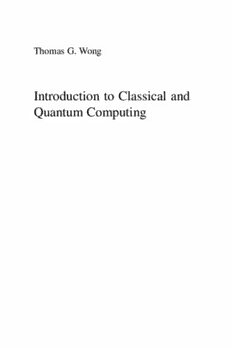Table Of ContentThomas G. Wong
Introduction to Classical and
Quantum Computing
Copyright©2022ThomasWong
All rights reserved. No part of this publication may be reproduced, distributed, or
transmittedinanyformorbyanymeans,incudingphotocopying,recording,orother
electronicormechanicalmethods,withoutthepriorwrittenpermissionofthepub-
lisher,exceptinthecaseofbriefquotationsembodiedincriticalreviewsandcertain
othernoncommericalusespermittedbycopyrightlaw.
ISBN:979-8-9855931-0-5(Paperback)
ISBN:979-8-9855931-1-2(Hardcover)
LibraryofCongressControlNumber:2022900358
BookdesignbyThomasWong
www.thomaswong.net
PublishedbyRootedGrove,Omaha,Nebraska
www.rootedgrove.com
345678910
Formystudents.
Preface
DearReader,
Thistextbookfornewcomerswhoareinterestedinquantumcomputingasapo-
tential career, but who may not be ready for advanced books or courses. The only
prerequisiteforthisbookistrigonometry,alsocalledpre-calculus.Youarenotex-
pectedtohavetakenadvancedmathbeyondthat,andyouarenotexpectedtohave
experiencewithprogramming.So,ifyouareanadvancedhighschoolstudentora
beginninguniversitystudent,thistextbookisforyou.
Thatsaid,thisbookisnotmerelyaconceptualoverviewofquantumcomputing.
I will teach the math and programming skills that may be missing. Since you are
interestedinquantumcomputingasapotentialcareer,Iwanttoequipyouwiththe
skillsyouwillneedformoreadvancedtopics.
If you are more advanced, and especially if you have already studied linear al-
gebra,thenyoumayfindthistextbooktooelementary.Foramoremathematically
rigorousintroductiontoquantuminformationscience,IreferyoutoQuantumCom-
putation and Quantum Information by Michael Nielsen and Isaac Chuang, affec-
tionatelycalled“MikeandIke,”likethechewy,fruitcandywiththesamename.It
isthestandardadvancedtext,andforgoodreason.
Ihopethistextbookwillhelpyourealizethatyoucandoit,thatyoucanunder-
stand quantum computing. I hope it will inspire you to study quantum computing
more deeply, and I hope that some of you might even choose quantum computing
as a career. If so, I look forward to calling you colleagues and learning from your
discoveries.
Thistextbookstemmedfromanintroductoryspecial-topicscoursethatItaught
atCreightonUniversity,andIthankeachclassofstudentsforsharingthejourneyof
developingandrefiningthecoursecontent.Imustalsothankthosewhohavetaught
mequantumcomputinginbothformalandinformalroles.Icouldnothavedoneit
withoutyou.
TomWong
v
Contents
1 ClassicalInformationandComputation .......................... 1
1.1 Bits ...................................................... 2
1.1.1 Coins .............................................. 2
1.1.2 Dice ............................................... 3
1.1.3 EncodingInformation ................................ 4
1.1.4 PhysicalBits ........................................ 5
1.1.5 Binary ............................................. 6
1.1.6 ASCII.............................................. 9
1.2 LogicGates ............................................... 11
1.2.1 Single-BitGates ..................................... 11
1.2.2 Two-BitGates....................................... 13
1.2.3 LogicGatesasPhysicalCircuits........................ 15
1.2.4 MultipleGates ...................................... 21
1.2.5 UniversalGates...................................... 23
1.3 AddersandVerilog ......................................... 27
1.3.1 AddingBinaryNumbersbyHand ...................... 27
1.3.2 HalfAdder ......................................... 28
1.3.3 FullAdder.......................................... 32
1.3.4 Ripple-CarryAdder .................................. 34
1.3.5 Ripple-CarrywithFullAdders ......................... 36
1.3.6 CircuitComplexity................................... 37
1.4 CircuitSimplificationandBooleanAlgebra..................... 37
1.4.1 OrderofOperations .................................. 38
1.4.2 Association,Commutivity,andDistribution .............. 38
1.4.3 IdentitiesInvolvingZeroandOne ...................... 39
1.4.4 Single-VariableIdentities ............................. 39
1.4.5 Two-VariableIdentitiesandDeMorgan’sLaws ........... 40
1.4.6 CircuitSimplification................................. 42
1.5 ReversibleLogicGates...................................... 44
1.5.1 ReversibleGates..................................... 44
1.5.2 IrreversibleGates .................................... 45
vii
viii Contents
1.5.3 ToffoliGate:AReversibleANDGate ................... 46
1.5.4 MakingIrreversibleGatesReversible ................... 48
1.6 ErrorCorrection ........................................... 52
1.6.1 ErrorsinPhysicalDevices............................. 52
1.6.2 ErrorDetection...................................... 54
1.6.3 ErrorCorrection ..................................... 55
1.7 ComputationalComplexity .................................. 58
1.7.1 AsymptoticNotation ................................. 58
1.7.2 ComplexityClasses .................................. 60
1.8 TuringMachines ........................................... 63
1.8.1 Components ........................................ 63
1.8.2 IncrementingBinaryNumbers ......................... 64
1.8.3 Church-TuringThesis ................................ 67
1.9 Summary ................................................. 71
2 OneQuantumBit .............................................. 73
2.1 QubitTouchdown:AQuantumComputingBoardGame.......... 73
2.2 Superposition.............................................. 74
2.2.1 ZeroorOne......................................... 74
2.2.2 Superposition ....................................... 76
2.2.3 ReviewofComplexNumbers.......................... 80
2.3 Measurement .............................................. 83
2.3.1 MeasurementintheZ-Basis ........................... 83
2.3.2 Normalization....................................... 85
2.3.3 MeasurementinOtherBases........................... 86
2.3.4 ConsecutiveMeasurements............................ 90
2.4 BlochSphereMapping...................................... 90
2.4.1 GlobalandRelativePhases............................ 91
2.4.2 SphericalCoordinates ................................ 92
2.4.3 CartesianCoordinates ................................ 95
2.5 PhysicalQubits ............................................ 97
2.6 QuantumGates ............................................ 98
2.6.1 LinearMaps ........................................ 98
2.6.2 ClassicalReversibleGates.............................100
2.6.3 CommonOne-QubitQuantumGates....................102
2.6.4 GeneralOne-QubitGates .............................108
2.7 QuantumCircuits ..........................................111
2.7.1 CircuitDiagrams ....................................111
2.7.2 Quirk ..............................................111
2.8 Summary .................................................112
3 LinearAlgebra ................................................115
3.1 QuantumStates ............................................115
3.1.1 ColumnVectors .....................................115
3.1.2 RowVectors ........................................116
Contents ix
3.2 InnerProducts .............................................118
3.2.1 InnerProductsAreScalars ............................118
3.2.2 Orthonormality......................................119
3.2.3 Projection,Measurement,andChangeofBasis ...........120
3.3 QuantumGates ............................................124
3.3.1 GatesasMatrices ....................................124
3.3.2 CommonOne-QubitGatesasMatrices ..................127
3.3.3 SequentialQuantumGates ............................128
3.3.4 CircuitIdentities.....................................129
3.3.5 Unitarity ...........................................131
3.3.6 Reversibility ........................................132
3.4 OuterProducts.............................................133
3.4.1 OuterProductsAreMatrices...........................133
3.4.2 CompletenessRelation ...............................135
3.5 Summary .................................................136
4 MultipleQuantumBits .........................................137
4.1 Entanglion:AQuantumComputingBoardGame................137
4.1.1 Mechanics..........................................137
4.1.2 ConnectiontoQuantumComputing.....................139
4.2 StatesandMeasurement.....................................140
4.2.1 TensorProduct ......................................140
4.2.2 KroneckerProduct ...................................142
4.2.3 MeasuringIndividualQubits...........................144
4.2.4 SequentialSingle-QubitMeasurements..................146
4.3 Entanglement..............................................147
4.3.1 ProductStates.......................................147
4.3.2 EntangledStates.....................................149
4.4 QuantumGates ............................................150
4.4.1 One-QubitQuantumGates ............................150
4.4.2 Two-QubitQuantumGates ............................153
4.4.3 ToffoliGate.........................................163
4.4.4 No-CloningTheorem.................................165
4.5 QuantumAdders ...........................................166
4.5.1 ClassicalAdder......................................166
4.5.2 MakingtheClassicalAdderaQuantumGate .............168
4.5.3 QuantumSetup......................................172
4.5.4 QuantumSum.......................................172
4.5.5 QuantumCarry......................................174
4.5.6 QuantumRipple-CarryAdder..........................175
4.5.7 CircuitComplexity...................................183
4.5.8 AddinginSuperposition ..............................184
4.6 UniversalQuantumGates....................................185
4.6.1 Definition ..........................................185
4.6.2 ComponentsofaUniversalGateSet ....................185
x Contents
4.6.3 ExamplesofUniversalGateSets .......................186
4.6.4 Solovay-KitaevTheorem..............................186
4.6.5 QuantumComputingwithoutComplexNumbers..........187
4.7 QuantumErrorCorrection ...................................188
4.7.1 Decoherence ........................................188
4.7.2 Bit-FlipCode .......................................190
4.7.3 Phase-FlipCode .....................................196
4.7.4 ShorCode ..........................................201
4.8 Summary .................................................207
5 QuantumProgramming ........................................209
5.1 IBMQuantumExperience ...................................209
5.1.1 Services............................................209
5.1.2 CircuitComposer ....................................212
5.1.3 QuantumProcessor ..................................215
5.1.4 Simulator...........................................218
5.2 QuantumAssemblyLanguage................................219
5.2.1 OpenQASM ........................................219
5.2.2 QuantumExperienceStandardHeader ..................221
5.2.3 OpenQASMinIBMQuantumExperience ...............222
5.2.4 QuantumAdder .....................................222
5.3 Qiskit ....................................................228
5.3.1 CircuitComposer ....................................228
5.3.2 QuantumLab .......................................229
5.3.3 Simulator...........................................232
5.3.4 QuantumProcessor ..................................234
5.4 OtherQuantumProgrammingLanguages ......................236
5.5 Summary .................................................236
6 EntanglementandQuantumProtocols ...........................237
6.1 Measurements .............................................237
6.1.1 ProductStates.......................................238
6.1.2 MaximallyEntangledStates ...........................238
6.1.3 PartiallyEntangledStates .............................238
6.2 BellInequalities............................................240
6.2.1 EPRParadoxandLocalHiddenVariables................240
6.2.2 BellInequalitiesandtheCHSHInequality ...............241
6.2.3 QuantumProcessorExperiment ........................246
6.2.4 OtherExperiments ...................................249
6.2.5 No-SignalingPrinciple ...............................249
6.2.6 OtherTheories ......................................251
6.3 MonogamyofEntanglement .................................253
6.3.1 ClassicalCorrelations ................................253
6.3.2 QuantumEntanglement...............................253
6.4 SuperdenseCoding .........................................255

